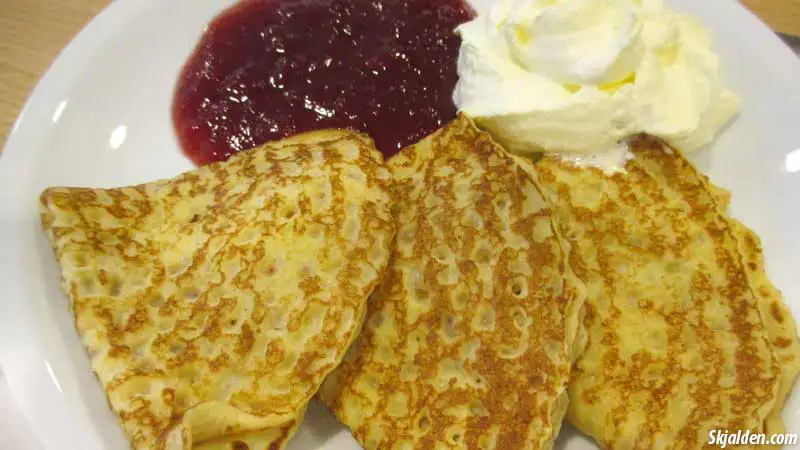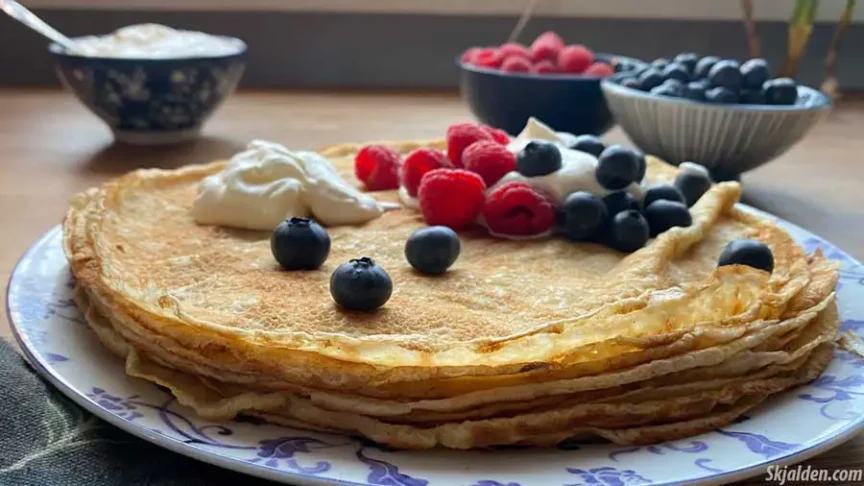Pannkakor are traditional Swedish pancakes known for their thin and slightly crispy edges. Similar to French crepes and thinner than American pancakes, they are made from a simple batter of eggs, flour, milk, and a pinch of salt. Unlike some pancake variations, traditional Pannkakor recipes usually don’t include sugar in the batter, focusing instead on the natural flavors that come to life when served with various toppings.
In Denmark, these pancakes are known as ‘pandekager,’ and they are identical to their Swedish counterparts, highlighting the shared culinary traditions between these countries.
Toppings for Pannkakor can range widely, from traditional options like lingonberry jam or strawberry jam to more modern choices such as Nutella, fresh fruit, and even ice cream. This versatility makes Pannkakor a favorite for many, as they can be tailored to individual tastes, whether one prefers something sweet or savory.
Some people enjoy putting the toppings on the pancake and rolling it up, while others prefer to simply put the toppings next to the pancakes.

Recipe: How to Make Pannkakor (Swedish Pancakes)
Pannkakor are a tasty Swedish treat, perfect for breakfast, dessert, or a cozy snack. This traditional recipe will guide you through making these thin, crepe-like pancakes, which can be enjoyed with a variety of toppings.
Ingredients:
2 cups (480 ml) of milk
1 cup (120 g) of all-purpose flour
2 large eggs
2 tablespoons of melted butter, plus more for frying
1/4 teaspoon of salt
Optional: 1-2 tablespoons of sugar (if you prefer a slightly sweeter batter)
Instructions:
Mix the Batter:
In a large mixing bowl, whisk together the milk, flour, eggs, melted butter, and salt until the batter is smooth. If you’ve chosen to add sugar, whisk it in now. Let the batter sit for about 30 minutes to allow the flour to absorb the liquid, resulting in a more cohesive batter.
Preheat the Pan:
Heat a non-stick frying pan or a traditional Swedish pannkakspanna (pancake pan) over medium heat. Add a small amount of butter to coat the surface of the pan lightly.
Cook the Pancakes:
Pour or ladle a thin layer of batter into the pan, tilting it to spread the batter evenly over the surface. Cook for 1-2 minutes or until the bottom is light golden brown and the edges start to lift slightly. Flip the pancake carefully using a spatula and cook the other side for another minute or until golden.
Serve and Enjoy:
Put the cooked pancake on a plate and cover it with a kitchen towel to keep it warm. Repeat with the remaining batter, adding more butter to the pan as needed.
Toppings:
Serve your Pannkakor warm with traditional toppings like lingonberry jam, or try them with strawberry jam, fresh fruit, Nutella, or whipped cream. For a savory twist, you can fill them with ham and cheese or sautéed mushrooms.
Enjoy your homemade Pannkakor with a cup of coffee or tea for a true Swedish fika experience!
History of Pannkakor
The history of the pancake, particularly Pannkakor, is somewhat ambiguous, tracing back to ancient times. Pancakes in some form have likely existed ever since humans began to cultivate and mill flour. Evidence suggests that even the Stone Age man, Ötzi, consumed primitive versions of pancakes before his demise. In ancient Greece, poets described a “flat dish” in the 5th century BC, known as teganites, derived from the Greek word ‘tagenon,’ meaning frying pan.
The term “pannkaka” can be traced back in the Swedish language to 1538. Initially, this dish might have contained colostrum, making its early versions quite different from what we define as pancakes today. In various local dialects, terms like ‘ostkaka’ (cheesecake) were also referred to as pancakes, indicating a diverse range of recipes and interpretations.
The modern iteration of the pancake, akin to what we recognize today as Pannkakor, likely emerged towards the end of the 19th century, coinciding with the introduction of iron stoves and frying pans, according to ethnologist Kurt Genrup.
It was around this time that the words and distinctions for ‘plättar’ (smaller pancakes) came into use, marking a difference in recipes where ‘plättar’ represented a more refined version, often containing cream. This evolution reflects the adaptability and cultural integration of pancakes over centuries, from a basic flatbread to the more sophisticated and varied pancakes we enjoy today.
Photo credit: Kaj Tallungs
